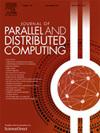Complexity analysis and scalability of a matrix-free extrapolated geometric multigrid solver for curvilinear coordinates representations from fusion plasma applications
IF 3.4
3区 计算机科学
Q1 COMPUTER SCIENCE, THEORY & METHODS
引用次数: 0
Abstract
Tokamak fusion reactors are promising alternatives for future energy production. Gyrokinetic simulations are important tools to understand physical processes inside tokamaks and to improve the design of future plants. In gyrokinetic codes such as Gysela, these simulations involve at each time step the solution of a gyrokinetic Poisson equation defined on disk-like cross sections. The authors of [14], [15] proposed to discretize a simplified differential equation using symmetric finite differences derived from the resulting energy functional and to use an implicitly extrapolated geometric multigrid scheme tailored to problems in curvilinear coordinates. In this article, we extend the discretization to a more realistic partial differential equation and demonstrate the optimal linear complexity of the proposed solver, in terms of computation and memory. We provide a general framework to analyze floating point operations and memory usage of matrix-free approaches for stencil-based operators. Finally, we give an efficient matrix-free implementation for the considered solver exploiting a task-based multithreaded parallelism which takes advantage of the disk-shaped geometry of the problem. We demonstrate the parallel efficiency for the solution of problems of size up to 50 million unknowns.
融合等离子体曲线坐标表示的无矩阵外推几何多网格求解器的复杂性分析和可扩展性
托卡马克聚变反应堆是未来能源生产的有希望的替代方案。陀螺动力学模拟是了解托卡马克内部物理过程和改进未来工厂设计的重要工具。在像Gysela这样的陀螺动力学代码中,这些模拟涉及在每个时间步解一个定义在圆盘状截面上的陀螺动力学泊松方程。[14],[15]的作者提出了利用由得到的能量泛函导出的对称有限差分来离散简化微分方程,并使用适合于曲线坐标问题的隐式外推几何多重网格方案。在本文中,我们将离散化扩展到一个更现实的偏微分方程,并在计算和内存方面证明了所提出的求解器的最佳线性复杂性。我们提供了一个通用框架来分析基于模板的操作符的浮点运算和无矩阵方法的内存使用。最后,我们给出了一个有效的无矩阵实现,利用基于任务的多线程并行性,利用了问题的磁盘形状几何。我们证明了求解规模高达5000万个未知数的问题的并行效率。
本文章由计算机程序翻译,如有差异,请以英文原文为准。
求助全文
约1分钟内获得全文
求助全文
来源期刊

Journal of Parallel and Distributed Computing
工程技术-计算机:理论方法
CiteScore
10.30
自引率
2.60%
发文量
172
审稿时长
12 months
期刊介绍:
This international journal is directed to researchers, engineers, educators, managers, programmers, and users of computers who have particular interests in parallel processing and/or distributed computing.
The Journal of Parallel and Distributed Computing publishes original research papers and timely review articles on the theory, design, evaluation, and use of parallel and/or distributed computing systems. The journal also features special issues on these topics; again covering the full range from the design to the use of our targeted systems.
 求助内容:
求助内容: 应助结果提醒方式:
应助结果提醒方式:


